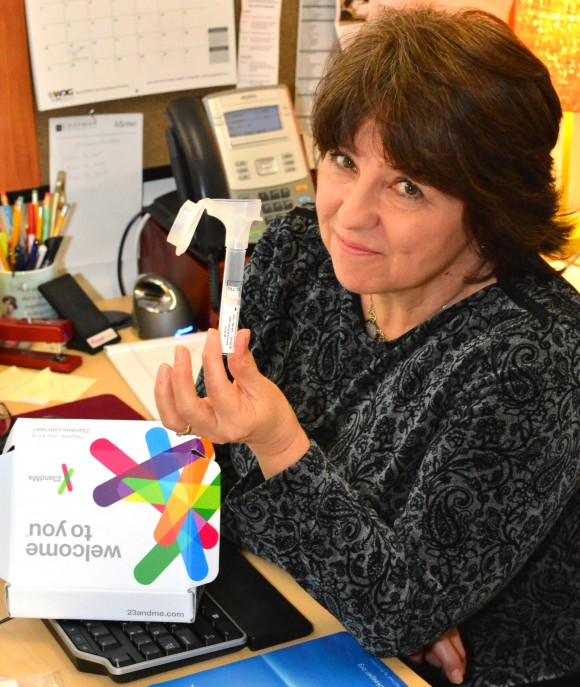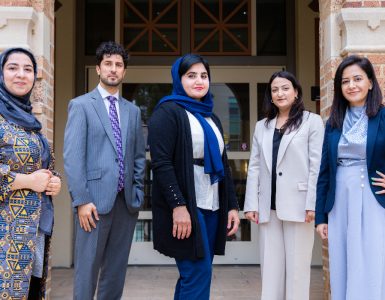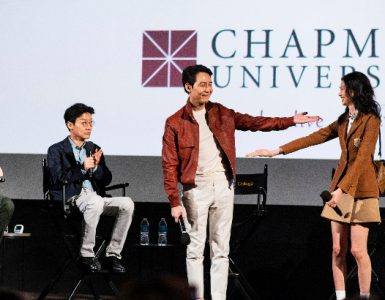I couldn’t make this up if I tried. Early this spring I sat in an airport waiting for my flight to Denver, the city where my father was abandoned as an hours-old infant, then discovered by a nurse and eventually adopted by the woman my brothers and I would someday call Nana.

Staff writer Dawn Bonker with her 23andMe saliva test tube. Chapman professor Michael Macpherson, pictured at top, created the program maps for 23andMe customers to sift through their genetic history.
As I awaited departure to the city of my father’s mysterious birth, I checked my email. My eyes widened when I saw the newest missive, a message from 23andMe, a genetic testing service.
About six weeks prior I had amused my family by spitting saliva into a vial, dispatching my DNA for analysis and, I hoped, some clues to my father’s ethnic ancestry.
Now my reports were ready. I held my breath in the airport terminal and tapped in the password to my account, ready to open a window into my past and glimpse the genetic stuff of me. My iPad screen filled with a colorful pie chart. At the center of the chart was a world map, highlighting the place where the biggest batch of my DNA soup originated.
I studied the map. Really? From there? I hadn’t seen that coming at all.
Questions and (DN)Answers
The scientist behind my ancestry locator map, and some 900,000 others created for customers of 23andMe, is Michael Macpherson, Ph.D., a genetic statistician and assistant professor of biological sciences in the
Schmid College of Science and Technology at Chapman University
.
Macpherson was among the first research scientists hired by the Silicon Valley testing service to work out the nuts and bolts behind 23andMe’s popular ancestry features. Named for the 23 pairs of chromosomes that comprise each person’s genome, the company offers services that are popular with genealogy buffs eager to locate distant relatives. Macpherson created the programs that generate the colorful maps of customers’ DNA trails around the globe. In addition, he contributed to the design of the company’s ancestry tool used for locating genetically related individuals.
The 23andMe reports occasionally reveal surprises such as unknown siblings and cousins, thanks to customer self-reporting, as documented by staff on the company blog. But the scientists also find revealing information in that massive dataset that offers insights into American identity. And it looks like many of us are fuzzy about much of that, particularly as it relates to African ancestry.
In a paper published in the American Journal of Human Genetics,
the authors reported that those with as much as 28 percent African ancestry are more likely to describe themselves as European American than as African American. People with more than 30 percent African ancestry tend to identify as African American. The scientists are keenly aware of the ripple effect their work has for questions about Americans’ perceptions of their race and identity. Macpherson and his colleagues helped research the genetic genealogy of guests on Finding Your Roots, a 10-part PBS series featuring historian Henry Louis Gates that explored some of those conversations.
Macpherson and his fellow researchers also found footprints of American history and migration patterns in their analysis of that swirling DNA stew, reported and displayed in a colorful
New York Times story and slide show. Among their findings was the discovery that Latinos in the Southeast showed more African DNA, while their counterparts in the Southwest carried more Native American ancestry.
Common among all the threads was a certain lopsidedness that researchers say echoes the legacy of slavery and sexual politics on the American frontier. The African and Native American blood lines were largely passed down by women, with paternal lineage more likely to come from European males. Stamped into all those DNA footprints are signs of our American identity, a sometimes surprising reality.
“It’s not so simple as what you see in the mirror, necessarily,” Macpherson says.
Who, What and Where
A few days after receiving my report, I was back on campus in Macpherson’s faculty office at Von Neumann Hall. When I showed him my personal version of the ancestry pie chart he devised, he leaned forward and grinned.
“Oh, wow! Look at that,” he said.
Yes, look at that.
“You have big chunks of Finnish.”
Indeed. It’s news to me. Tiny blips of Asian and Native American appear, too — perhaps the legacies of my ancestors mingling with indigenous people of the Arctic or the Americas. There’s also a significant chunk of Italian, 11.6 percent to be exact, an amount Macpherson says could indicate an Italian great-grandparent. The lineage on my mother’s side is pretty well documented for several generations. No known Italians.
It’s speculative because females inherit only a portion of their paternal DNA; the male Y chromosome passes only to sons. So we eagerly await my brother’s DNA report. Still, I thought of my father’s olive complexion and thick black hair. It’s a step closer. I texted my brother: “Hitch up the reindeer and go out for pasta.”
But Finnish? I am a far cry from the tall, cool blondes I associate with Nordic countries. It could be from either side. Finnish blood in people who claimed German heritage? It’s not impossible, says Shira Klein, Ph.D., an assistant professor in the
Department of History
at Chapman and an expert on European migration patterns.
At various times throughout history, Germans migrated back and forth to Sweden to work in the mines, as did large numbers of Finns, Klein said.
“Perhaps you had a Finnish ancestor and a German ancestor who met in Sweden,” Klein said. My German ancestors also lived in Russia for a time, possibly as part of German colonies. Many Finns migrated to Russia in those years, too, Klein said. So there could have been what Macpherson describes in genetic statistician language as “a breeding event.”
“Perhaps” and “could” are the operative words here. Speculation is my game now.
Or was, until that ancestry finder tool Macpherson helped devise sparked a memory. A member of the DNA registry showed up as a third cousin. A family surname this Utah man listed was one I recalled from my mother’s side of the family. There had long been a tale of a range war in that part of the family tree. It seemed like a good time to fact-check. I dug out marriage certificates, obituaries and handwritten family histories. I read state histories digitized by hardworking librarians.
Yup. My great great-grandfather was shot clean off his horse, the shooter claiming self-defense. My oldest son, a student at Chapman University’s Dale E. Fowler School of Law, researched the trial and appeal. It turns out the case helped set self-defense precedent in the state of Colorado.
So, we hail from history-makers — of a sort, anyway. When I shared the story with Macpherson, I joked that I’m grateful to be descended from the daughter of my reckless grandpa. Here’s hoping the bad-decision gene that makes a man point a loaded rifle at his enemy sticks like glue to that Y chromosome. Not to worry, Macpherson says. A great-great-grandparent contributes just one-sixteenth of my genome.
“Plenty of room left over for playing well with others,” he teased.
I’ll take that. We all have plenty of room to improve, reinvent, forge new paths, change ways, and make progress and history — history of all sorts, no matter where we come from or how we get here.
And isn’t that the real stuff of American DNA?





So fascinating and useful as so much has been forgotten.
Loved this article…just went on the “23andMe” website to order each of my parents a test-kit. Hilarious! My dad is very into genealogy, so it’ll be a perfect gift (I hope!)